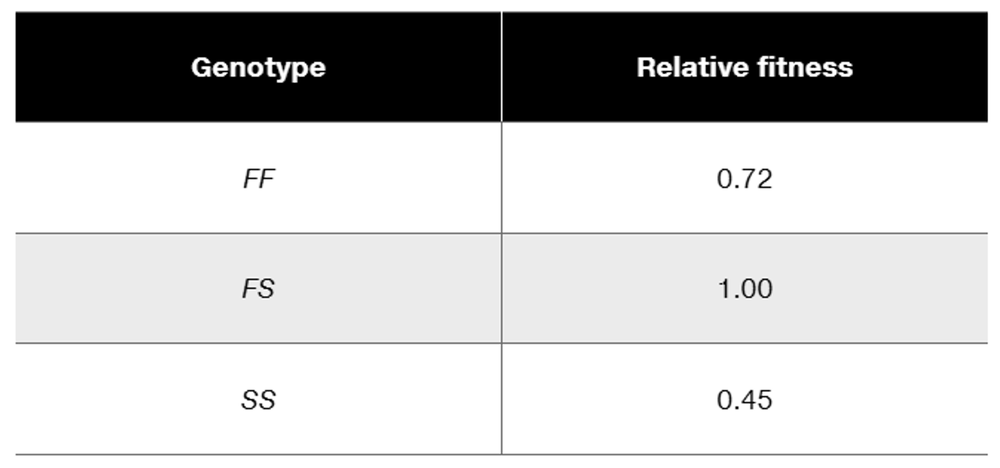Epidemiologic data on the population in the previous problem reveal that before the application of modern medical treatment, natural selection played a major role in shaping the frequencies of alleles. Heterozygous individuals have the highest relative fitness, and in comparison with heterozygotes, those who are βᴬβᴬ have a relative fitness of 82%, but only about 32% of those with SCD survived to reproduce. What are the estimated equilibrium frequencies of βᴬ and βˢ in this population?
Table of contents
- 1. Introduction to Genetics51m
- 2. Mendel's Laws of Inheritance3h 37m
- 3. Extensions to Mendelian Inheritance2h 41m
- 4. Genetic Mapping and Linkage2h 28m
- 5. Genetics of Bacteria and Viruses1h 21m
- 6. Chromosomal Variation1h 48m
- 7. DNA and Chromosome Structure56m
- 8. DNA Replication1h 10m
- 9. Mitosis and Meiosis1h 34m
- 10. Transcription1h 0m
- 11. Translation58m
- 12. Gene Regulation in Prokaryotes1h 19m
- 13. Gene Regulation in Eukaryotes44m
- 14. Genetic Control of Development44m
- 15. Genomes and Genomics1h 50m
- 16. Transposable Elements47m
- 17. Mutation, Repair, and Recombination1h 6m
- 18. Molecular Genetic Tools19m
- 19. Cancer Genetics29m
- 20. Quantitative Genetics1h 26m
- 21. Population Genetics50m
- 22. Evolutionary Genetics29m
21. Population Genetics
Hardy Weinberg
Problem 24a
Textbook Question
In the mouse, Mus musculus, survival in agricultural fields that are regularly sprayed with a herbicide is determined by the genotype for a detoxification enzyme encoded by a gene with two alleles, F and S. The relative fitness values for the genotypes are

Why will this pattern of natural selection result in a stable equilibrium of frequencies of F and S?
 Verified step by step guidance
Verified step by step guidance1
Understand the concept of relative fitness: Relative fitness measures the reproductive success of a genotype compared to others in the population. In this case, FS has the highest relative fitness (1.00), followed by FF (0.72) and SS (0.45). This indicates that heterozygotes (FS) are favored by natural selection.
Recognize the type of selection: The pattern of relative fitness values suggests heterozygote advantage (also known as overdominance). This occurs when the heterozygous genotype has a higher fitness than either homozygous genotype, leading to a stable equilibrium of allele frequencies.
Explain the equilibrium mechanism: In heterozygote advantage, natural selection maintains both alleles in the population because the heterozygous genotype (FS) is the most fit. If one allele becomes too rare, the likelihood of producing heterozygotes decreases, reducing overall population fitness. Selection then favors the rarer allele to restore balance.
Describe the mathematical basis: The equilibrium frequency of alleles F and S can be calculated using population genetics equations that account for relative fitness values. The equilibrium occurs when the change in allele frequencies due to selection is zero, meaning the population reaches a stable state where both alleles are maintained.
Conclude why equilibrium is stable: The stable equilibrium arises because neither allele can completely replace the other due to the fitness advantage of heterozygotes. This ensures that both alleles persist in the population over time, maintaining genetic diversity.
 Verified video answer for a similar problem:
Verified video answer for a similar problem:This video solution was recommended by our tutors as helpful for the problem above
Video duration:
2mPlay a video:
Was this helpful?
Key Concepts
Here are the essential concepts you must grasp in order to answer the question correctly.
Natural Selection
Natural selection is a fundamental mechanism of evolution where individuals with advantageous traits are more likely to survive and reproduce. In this context, the relative fitness values of the genotypes indicate how well each genotype performs in the presence of herbicide. The FS genotype has the highest fitness, suggesting it is favored in the environment, while FF and SS are less fit.
Recommended video:
Guided course

Natural Selection
Genotype Frequencies
Genotype frequencies refer to the proportion of different genotypes within a population. In this scenario, the frequencies of the F and S alleles will change over time due to natural selection. The stable equilibrium occurs when the rates of increase and decrease of these genotypes balance out, leading to a consistent presence of both alleles in the population.
Recommended video:
Guided course

Gamete Genotypes
Stable Equilibrium
A stable equilibrium in population genetics occurs when allele frequencies remain constant over time, despite ongoing selection pressures. In this case, the relative fitness values create a balance where the advantageous FS genotype maintains its frequency, while the less fit genotypes do not completely disappear. This dynamic allows for the coexistence of both alleles, F and S, in the population.
Recommended video:
Related Videos
Related Practice
Textbook Question
323
views



